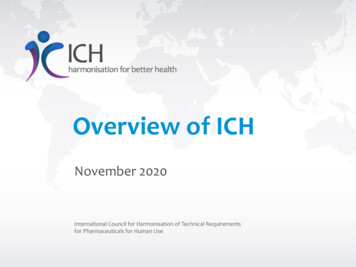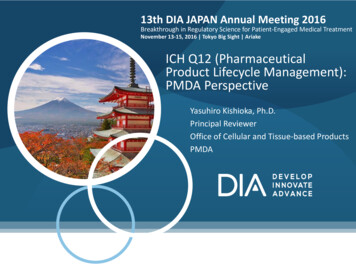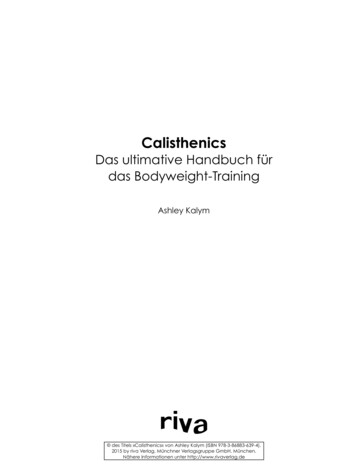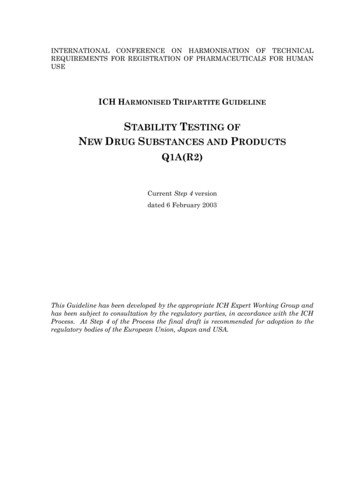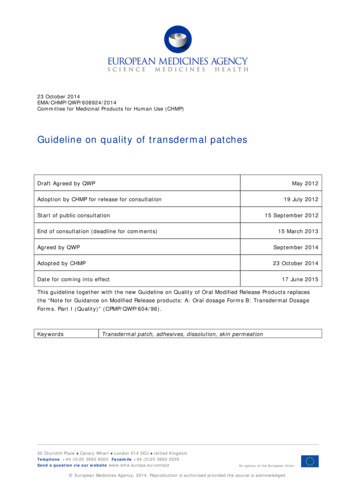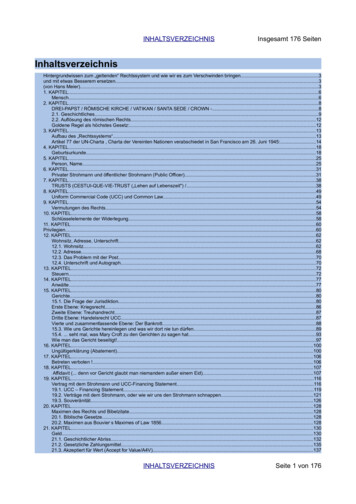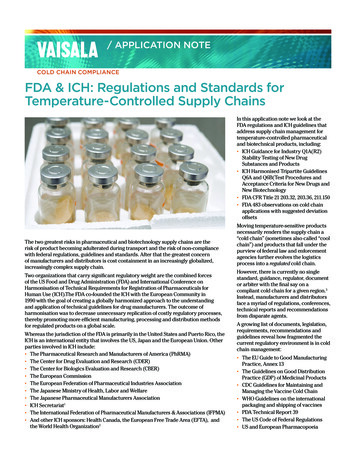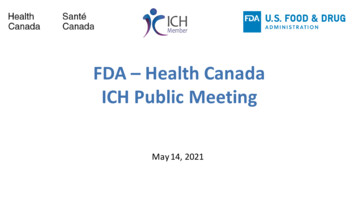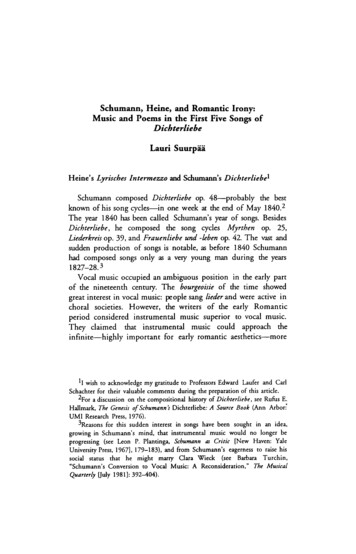
Transcription
Joint BWP/QWP/GMDP IWG – IndustryEuropean Workshop on Lifecycle ManagementApplication of ICH Q12 Tools and EnablersPost-Approval Lifecycle Management Protocols1
Outline Introduction: evolution of PACMP concept Expanded (multi-site, multi-product) changemanagement protocols (Roche, presenter:Wassim Nashabeh) Risk-based (step-2) Variation classification incase of changes for biological products inaccordance with an approved Post ApprovalChange Management Protocol (J&J/ Janssen,presenter: Ronald Imhoff)2
Introduction: ICH Q12 – evolution ofPACMP concept Current Q12 draft GL contains evolving concepts regardingPACMPs that warrant a further discussion based on examples:12
Example 1: Roche/Genentech Site Transfers under an “Expanded ChangeManagement Protocol”: multi-site/ multiproduct approach (presenter: WassimNashabeh) Key Question: what needs to be in ICH Q12to enable such expanded approaches in allregions?
Expanded Protocols - Outline Introduction/ background Case Study: Considerations for expanded post-approval change managementprotocol (ePACMP) for Site Transfer:– Scope– Quality Risk Management (QRM)– Inspection Management/ PQS– Comparability– Validation Summary5
Site Transfers are required to support networkmobility and mitigate risk post-approval To meet world-wide demand for the drug– Manufacturing plant capacity is often limited and must be balancedacross a broad network of facilities and products To mitigate risk associated with single sourcing to ensure supplyto patients– Reduce Risk for out of stock situations– Safety backup / risk mitigation, in case one site cannot produce materialfor various reasons Natural disasters Loss by fire Equipment break-down Flexibility to supply all markets6
Site Transfer of Product A to Site Y Leveraging‘traditional’ protocol in the US & EUDefined business needProduct ASubmit protocoldescribing sitetransfer acceptancecriteria for productsite combinationA B CDrug SubstanceDonor Site XExecute transferper definedrequirements inprotocolDASupplement/variation with datademonstratingacceptance criteriametDrug SubstanceReceiving Site Y7
Example (EU): Biologics DS manufacturing site transfer Benefit of PACMP Approach vs. „Traditional“ Approach*PACMP Up to 5 months faster approval ofthe site change using a PACMP(time benefit similar in US)*Note: approval timelines for type II variation in this scheme include positive CHMP opinion and Commission Decision8
Site Transfer Leveraging expanded Comparability Protocol(eCP) – a reflection of the experience with US-FDAA network of Drug SubstanceReceiving SitesA network of DrugSubstance Donor SitesPotential Future NetworkRequirementsSite Y or ZASite XASiteYBBSite ZDSite X or ZCSite X or ZDSite X or YCSubmit eCP describing sitetransfer acceptance criteriabroadly for both Site andProductExecute transferper definedrequirements ineCPCBE-30 Supplementwith datademonstratingacceptance criteria met9
eCP Site Transfer General Strategic FrameworkeCPcGMPAcceptance CriteriaQuality Risk ManagementScope and Limitations
Strategy & Scope of the Site Transfer eCP The primary objective of the Site Transfer eCP is to support the mobility acrossdrug substance manufacturing sites, i.e. transfer from one donor site to one ormore recipient site(s):– Several monoclonal antibodies– Several sites, incl. CMOs (sites already licensed with appropriate inspectionrecord)– Reduces the number of regulatory submissions of similar content and drivesconsistency– Effectively leverages concepts of Quality Risk Management and ICH Q9– Builds upon company’s experience with site transfers across products andsites Scope excludes opportunistic significant process changes; typical process adaptionslinked to scale and equipment differences in scope11
Site Transfer Risk Assessment Considerations Performed for each site transfer Identifies, scores, and documents the potential hazard and harm associatedwith each unit operation and process change, as well as the prevention anddetection controls Accounts for known elements of the process– Robustness– Existing controls– Potential impact to product quality Considers the subjectivity of risk assessment– Team– Facilitator– Training– Consistency and calibration of risks– Severity, Occurrence, Detection scoring definitions12
Site Transfer Risk Assessment ExampleFailure modes prospectively identified and assessed by team of expertsNote: Risk Priority Number (RPN) is the product of the Primary Risk Number (PRN) and the scorefor probability of detection.13
Risk Prioritization MatrixIdentified thresholds of risk acceptability incorporated in overall applicability to SiteTransfer eCP14
Inspection Management (overlap with Inspection/PQS session)Site Inspection Assessment: Risk-ranking tool provides a generic approach to assess siteand process risks for technical transfers, incl. CMOs Will help to understand the level of overall inspectional riskat the recipient site Will serve as an evaluation of the GMP compliance status ofthe recipient site Highlights the importance of assessor-inspectorcollaboration15
Site inspection assessment - risk ranking tool(overlap with Inspection/ PQS session)Risk factorsFacilityCMO vs. internal networkFacility experienceInspection history etc.ProductRaw materials usedTech. Transfer experienceProduct knowledge etc.ProcessSimilarity to existing processProcess knowledgeManufacturing complexity etc.ExperienceWorkforce experienceQuality systemTechnology competence etc.Risk levelSubmission requirementslowIn scope of protocol, moderatechange submission (CBE-30, Ibvar.); stress stability data onlymediumIn scope of protocol, moderatechange submission (CBE-30, Ibvar.), incl. 6-month real-timestability datahighOutside of scope of protocol,i.e. major change submission16
Comparability ApproachTransfer to anew site withfacility fitchanges withno expectedchange toproductcharacteristicsCategoryAA BA B COut of scopeof protocolconceptComponentsThe basic package: QC lot release data, including potency extended physico-chemical characterization methods accelerated degradation, with real-time stability and commitments process-related impurity levels (host cell proteins, DNA, ProteinA)Biological characterization: Fcγ receptor assays, FcRn, ADCC Biacore or other binding assaysAnimal PK or PK/PD studies: rodent PK may suffice may need primates for PDA B C DClinical PK (comparability bridging study): direct comparison to licensed process material in human subjectsA B C EClinical experience or efficacy may need to confirm efficacy, lack of AEs, lack of immunogenicity might be a “clinical experience” study, or head-to-head vs.licensed process17
Overall Comparability Plan for Site Transfer Drug Substance must meet all release and in-process specifications, as well ascomparability acceptance criteria (e.g., tolerance intervals [TI, 95/99]) derived fromentire manufacturing history– Specifications provide assurances of product quality– Comparability acceptance criteria provide assurances of consistency withprevious processes Analytical profiles from selected characterization tests are consistent with pre-changematerial in side-by-side comparisons Process performance attributes– Cell culture performance– Purification process yields– Impurities levels Drug Substance degradation studies consistent with pre-change material18
Submissions without Real Time Stability Data(link to lifecycle strategy) Traditionally rate-limiting to site transfer timelines, this approach speeds timeto regulatory submission and introduction to the market19
Process validation Provides an overview of validation project plan and validationmaster plan for the site transfer in accordance to the currentPQS system Summary of validation studies performed to support the sitetransfers, e.g. studies adopted from donor site and new studiesat the recipient site will be part of the step-2 implementationsubmissions (CBE-30 or type Ib)20
SummaryeCP Strategic ComponentePACMP step 1 contents (registration of protocol)ePACMP step 2 contents (changeimplementation)Overall Strategy (Scope and Limitations)Defined scope and limitationsDemonstrate requirements of scope met, includingprocess changes associated with transferQRMDescription of QRM program and approach to sitetransfer risk assessmentDocumented risk control strategy and executedrisk management report summaryComparability & StabilityComparability plan, real-time stability commitments andacceptance criteria(product Specific)Data demonstrating that acceptance criteria aremetProcess ValidationOverview of validation programSummary of facility/equipment differences andapplicable validation; Validation summary datasupport the process, facility/equipment, andmethod transferInspectionDescription of Site inspection assessment - risk rankingtoolOutcome of inspection risk ranking tool definesactual change submission requirements21
Example 2: J&J/ Janssen Risk-based (step-2) Variation classification incase of changes for biological products inaccordance with an approved Post ApprovalChange Management Protocol (presenter:Ronald Imhoff)
Current PACMP procedure for chemicaland biological productsWhy is step 2 for biologal products per definition IB ?23
Introduction: ICH Q12 – evolution ofPACMP concept Current ICH Q12 draft GL contains new concepts regardingPACMPs that warrant a further discussion based on examples:2
The use of a PACMP is enabled through an effective quality riskmanagement system (ICH Q9) and change management system as part ofa sound pharmaceutical quality system (ICH Q10). Components of a PACMP include the following elements:– A detailed description, including a rationale, of the proposed change(s). Thedifferences before and after the proposed change should be clearly highlighted.– Specific tests and studies to be performed, such as: characterization, release,stability as appropriate, in-process controls. The PACMP should include adescription of the analytical procedures and proposed acceptance criteria for eachtest or study.– A quality risk management plan to assess the impact on product quality followingimplementation of the change(s), and if multiple changes are to be implemented,addressing the potential risk from the cumulative effect of multiple changes and/orhow they are linked.– Supportive data from previous experience with the same or similar productsrelated to: development, manufacturing, characterization, release, and stability toallow for risk mitigation– Discussion on the appropriateness of the approved control strategy to oversee theplanned changes– Proposed reporting category for the implementation of step 2 of the PACMP
Examples of PACMPType of changeRisklevelReprocessing: re-filtration (0.45 and 0.2 µm in series) of Protein Aclarified harvest in the event of a filter integrity failureReprocessing: Repeating the viral removal filtration in the event ofa filter integrity failureReprocessing: Re-concentration in the event of over-dilution inthe Concentration / Diafiltration manufacturing stepScale up: Change in size (width) of chromatography column.No impact on Critical Process Parameters (established condition)Very LowLowLowVery LowAddition of drug substance manufacturing site (within company). MediumNo change in manufacturing process.New site already inspected by an European Inspectorate26
Reprocessing: Re-filtration of Protein A clarifiedharvest in the event of a filter integrity failurePACMP (step 1) contains:––––––Description of the changeData from reduced scale studies; 2 successful independent filtrationsCommitment to perform one commercial scale studyProposed tests with acceptance criteriaRisk assesmentCommitment that reprocessing is within established hold time Does this require review of the results by the Agency (step 2 )before the change can be implemented?27
Proposed reporting category (step 2) based on riskassessment taking into account amongst others- complexity of the change- available (reduced scale) data to support the proposed change- impact on product quality (CQA/CPP/CMA)- product and process understanding- status of PQSRisk levelVariation classification for step 2Very lowDo and Record (PQS & ProductQuality Review)LowDo and Tell: Type IAMediumDo and Tell: Type IAINHighTell and Do: Type IB
Proposed variation classification for step 2of the PACMPType of changeRisk levelRisk-based Variationclassification . How to filethe data?Reprocessing: re-filtration (0.45 and 0.2 µm inseries) of Protein A clarified harvest in the eventof a filter integrity failureReprocessing: Repeating the viral removalfiltration in the event of a filter integrity failureVery LowDo and Record (PQS &Product Quality Review)LowDo and Tell: Type IAReprocessing: Re-concentration in the event ofover-dilution in the Concentration / Diafiltrationmanufacturing stepLowDo and Tell: Type IAAddition of drug substance manufacturing site(within company). No change in manufacturingprocess.New site already inspected by an EuropeanInspectorateMediumDo and Tell: Type IAIN29
Proposed variation classification for step 2of the PACMPType of changeRisk levelRisk-based Variationclassification . How to filethe data?Scale up: Change in size (width) ofchromatography column. No impact on CriticalProcess Parameters (established condition)Very lowDo and Record (PQS &APR)Change in anion exchange resin(chromatography column). Has impact onCritical Process Parameters (establishedcondition)LowDo and Tell: Type IAMajor change in fermentation process(continuous perfusion to fed batch)Has impact on Critical Process Parameters(established condition)HighTell and Do: Type IB30
Summary The current PACMP procedure where step 2 for biologicalproducts is per definition a type IB variation is too restrictive. The variation classification for step 2 proposed in step 1 (typeII variation) should be risk-based. Options are do and record(PQS), do and tell (type IA or IAIN) and tell and do (IB) This principle could also be applicable for chemicalsubstances.
Questions The proposed reporting category for step 2 should be risk based.What would be an appropriate tool for this risk evaluation and howis the reporting category then defined? Linked to bullet 1.How should the Commission’s Guideline on the details of thevarious categories of variations to the terms of marketingauthorisations for medicinal products for human use and veterinarymedicinal products (2010/C 17/01) that supports the VariationsRegulation (Commission Regulation (EC) No 1234/2008) beadapted? What are the challenges of implementing this in all ICH regions? Is there a need to differentiate between chemical and biologicalproducts?
Questions, continued Question from previous presentation(expanded protocols): what needs to be inICH Q12 to enable such expandedapproaches in all regions?
management system (ICH Q9) and change management system as part of a sound pharmaceutical quality system (ICH Q10). Components of a PACMP include the following elements: - A detailed description, including a rationale, of the proposed change(s). The differences before and after the proposed change should be clearly highlighted.
